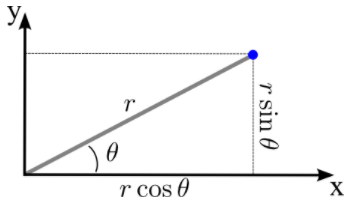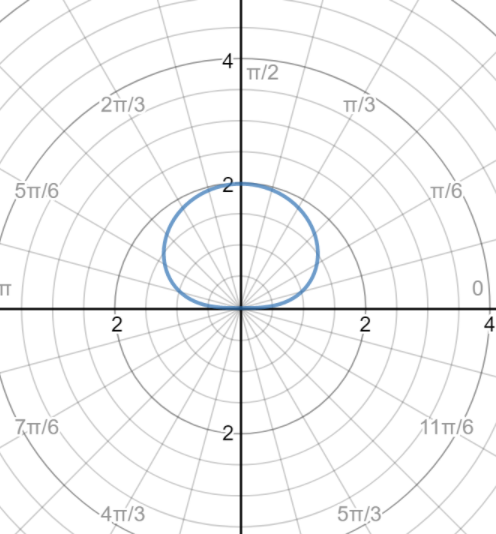
Please help How do I graph the polar equation ${{r}^{2}}=4\sin \theta $ ?
Answer
537k+ views
Hint: We will first convert the following equation in polar coordinate equation format and solve it accordingly and plot it in graph.
Complete step by step answer:
First we will consider a function of the type:
\[r=f\left( \theta \right)\]
So we will give values of the angle $\theta $ and the function gives you values of $r$.
To graph polar functions, we have to find points that lie at a distance $r$ from the origin and form (the segment $r$) an angle $\theta $ with the x-axis.
We can calculate Cartesian coordinates of a point with polar coordinates \[(r,\theta )\] by forming the right triangle. The hypotenuse is the line segment from the origin to the point, and its length is \[r\]. The projection of this line segment on the x-axis is the leg of the triangle adjacent to the angle \[\theta \], so \[x=rcos\theta \]. The y-component is determined by the other leg, so \[x=rcos\theta \] .
Our conversion formula is:
$\begin{align}
& x=r\cos \theta \\
& y=r\sin \theta \\
\end{align}$

So now coming to our question, we have:
${{r}^{2}}=4\sin \theta $
Now here we will shift the root on the right hand side, we get:
$r=2\sqrt{\sin \theta }$
Now from this we can see that radius is having a negative number, as such the square of the radius cannot equal a negative number, therefore we must add the following restriction:
\[{{r}^{2}}=4sin(\theta );0\le \theta \le \pi \]
With this, this allows us to take the square root of both sides of the equation without being concerned with the negative values.
So we get:
\[r=2\sqrt{\sin \left( \theta \right)};0\le \theta \le \pi \]
With this we will get a graph of equation as follows:

Note:
A polar equation is any equation that describes a relation between \[r\] and $\theta $, where \[r\] represents the distance from the pole (origin) to a point on a curve, and $\theta $ represents the counterclockwise angle made by a point on a curve, the pole, and the positive x-axis.
Complete step by step answer:
First we will consider a function of the type:
\[r=f\left( \theta \right)\]
So we will give values of the angle $\theta $ and the function gives you values of $r$.
To graph polar functions, we have to find points that lie at a distance $r$ from the origin and form (the segment $r$) an angle $\theta $ with the x-axis.
We can calculate Cartesian coordinates of a point with polar coordinates \[(r,\theta )\] by forming the right triangle. The hypotenuse is the line segment from the origin to the point, and its length is \[r\]. The projection of this line segment on the x-axis is the leg of the triangle adjacent to the angle \[\theta \], so \[x=rcos\theta \]. The y-component is determined by the other leg, so \[x=rcos\theta \] .
Our conversion formula is:
$\begin{align}
& x=r\cos \theta \\
& y=r\sin \theta \\
\end{align}$

So now coming to our question, we have:
${{r}^{2}}=4\sin \theta $
Now here we will shift the root on the right hand side, we get:
$r=2\sqrt{\sin \theta }$
Now from this we can see that radius is having a negative number, as such the square of the radius cannot equal a negative number, therefore we must add the following restriction:
\[{{r}^{2}}=4sin(\theta );0\le \theta \le \pi \]
With this, this allows us to take the square root of both sides of the equation without being concerned with the negative values.
So we get:
\[r=2\sqrt{\sin \left( \theta \right)};0\le \theta \le \pi \]
With this we will get a graph of equation as follows:

Note:
A polar equation is any equation that describes a relation between \[r\] and $\theta $, where \[r\] represents the distance from the pole (origin) to a point on a curve, and $\theta $ represents the counterclockwise angle made by a point on a curve, the pole, and the positive x-axis.
Recently Updated Pages
A man running at a speed 5 ms is viewed in the side class 12 physics CBSE

The number of solutions in x in 02pi for which sqrt class 12 maths CBSE

State and explain Hardy Weinbergs Principle class 12 biology CBSE

Write any two methods of preparation of phenol Give class 12 chemistry CBSE

Which of the following statements is wrong a Amnion class 12 biology CBSE

Differentiate between action potential and resting class 12 biology CBSE

Trending doubts
What are the major means of transport Explain each class 12 social science CBSE

Which are the Top 10 Largest Countries of the World?

Draw a labelled sketch of the human eye class 12 physics CBSE

How much time does it take to bleed after eating p class 12 biology CBSE

Explain sex determination in humans with line diag class 12 biology CBSE

Explain sex determination in humans with the help of class 12 biology CBSE




